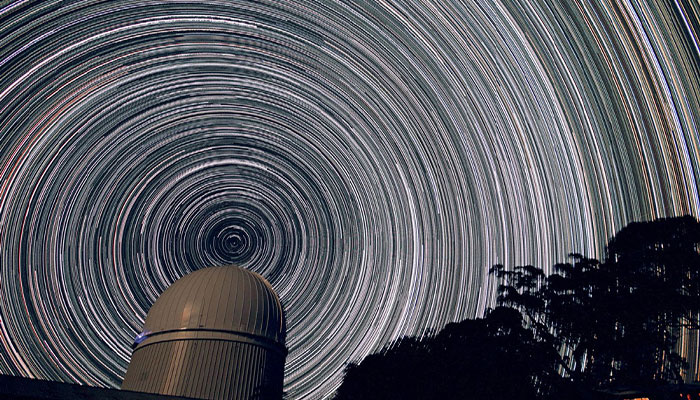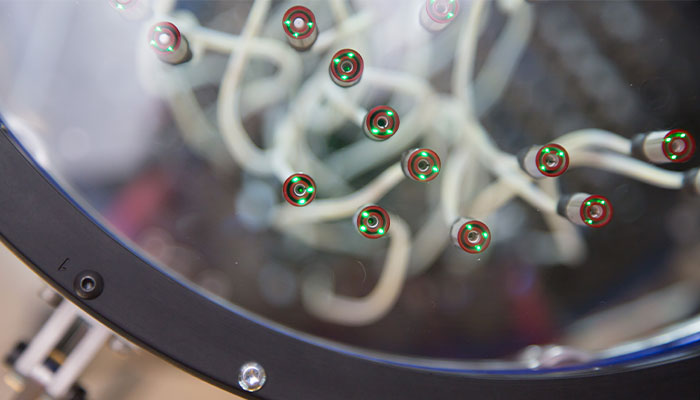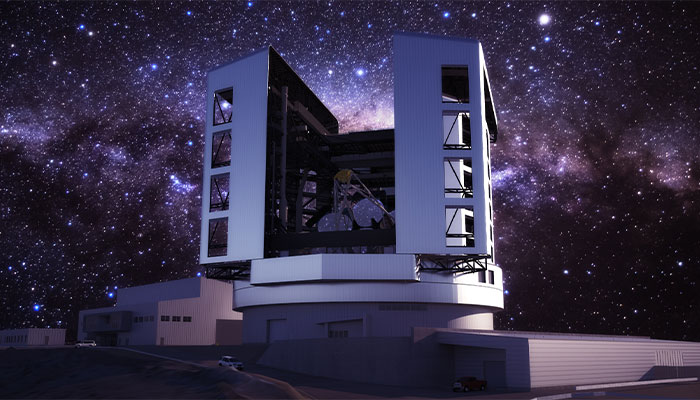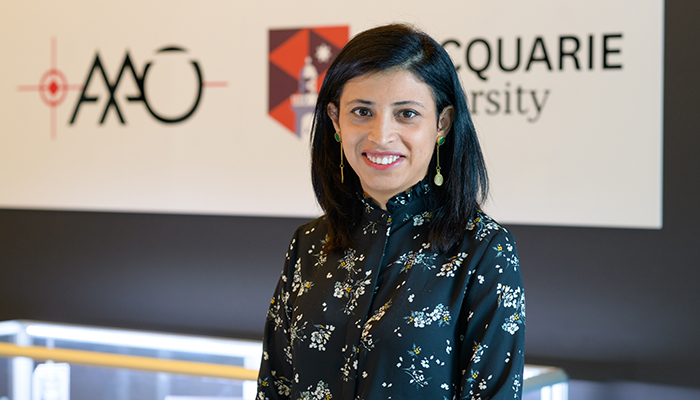A revolutionary astronomy system called TAIPAN, developed by Macquarie University researchers at the Australian Astronomical Observatory (AAO), is set to transform astronomy research around the world.

Hello, universe: A time lapse image of the night sky from Siding Spring Observatory. Picture credit: Ángel R. López-Sánchez (AAO-MQ).
The TAIPAN instrument, installed on the UK Schmidt Telescope at Siding Spring Observatory, uses small robots called Starbugs to rapidly move individual optical fibres around a glass plate in the focal plane of the telescope, so astronomers can measure the visible light from thousands of celestial objects in a single night.
“We started developing the TAIPAN system in 2013 and over the last eight years, we have refined it to the point where we are in the final stages of verification,” says Rebecca Brown, an optical engineer with Australian Astronomical Optics, part of Macquarie University’s Science and Engineering Faculty.
Although the TAIPAN prototype has been operating since 2018, the research team have since worked to iron out various software bugs, improving and stabilising the robot operations to reach to a steady state where Starbugs do not collide, tangle or block each other.
Starbugs use clever software to move dozens – even hundreds – of fibres simultaneously, greatly increasing the volume of information that astronomers can gather.
Brown says the name Starbugs came from an earlier version of the tiny robots which made a noisy buzzing sound as they moved across the telescope.
It’s certainly apt: viewed from above, the myriad tiny robots swarming across the starlit glass plate to precisely position optical fibres look just like insects hovering around a streetlight.
But these little bugs deliver such revolutionary changes to the way that astronomers can capture information, that they have attracted multimillion-dollar projects to the AAO.
De-bugging the optical fibre systems
Astronomer Dr Tayyaba Zafar says that Starbugs will recapture valuable hours of night sky observation time previously devoted to moving equipment around.

Revolution: The Starbugs in action on a glass plate ... they will recapture valuable hours of observation time previously spent moving equipment around. Picture credit: Andy Green
In the early days, a technician would have to manually move the photographic glass or metal plates into place and plug in an optical fibre to the correct position. This process could take over an hour and lots of involved day time work to make maximum use of the night hours.
External positioning robots were then developed to move optical fibres very precisely – but each one had to be carefully calibrated and only a single fibre was moved each time.
Starbugs use clever software to move dozens – even hundreds – of fibres simultaneously, greatly increasing the volume of information that astronomers can gather.
- Please explain: What lies behind the cryptocurrency mania?
- As another lockdown bites, is complacency to blame?
The development of TAIPAN has been a major technical challenge – and Zafar says that the team has always considered the future international possibilities of the system.
Examples include the Keck telescope in Hawaii, and the billion-dollar, 25-metre Giant Magellan Telescope under construction in Chile, via a partnership between Australia, US, Brazil, South Korea and Chile as the host country, due to be completed in 2029.
Zafar says that the Giant Magellan Telescope’s plates could eventually accommodate nearly a thousand Starbugs.
History-making Southern Sky star maps
Operational testing of TAIPAN is carried out at the AAO’s UK Schmidt Telescope, built in 1973, which sits about a thousand metres above sea level at the Siding Spring Observatory, in the Warrumbungle Range near Coonabarabran in the NSW Central West.
The telescope was originally designed as a giant camera, using massive gears to slowly rotate the enormous 1.24-metre lens around the observatory’s huge skyward-facing dome to record images of the skies onto large, 35cm-square photographic glass plates.
We can operate the telescope remotely to make sure that everything is progressing to plan, rather than being on top of a mountain in winter, in the middle of the night!
On a good night, technicians would manually refocus the lens to the right position to expose five or six glass plates to the night skies over many hours, allowing the plates to capture fainter objects over greater distances.
These images became the main maps of the southern hemisphere sky for almost 30 years.
But while film plates would take hours to record a section of the sky, and manually moving the cumbersome instruments ate into valuable observation time, new digital image sensors installed in the 1990s were literally light-years ahead.
Remarkable remote technology
Optical fibres that capture light from many stars or galaxies at the same time use a process called multi-object spectroscopy.

Bright future: Plates of the Giant Magellan Telescope under construction in Chile could eventually accommodate nearly a thousand Starbugs. Picture credit: GMTO
The optical fibres feed the light into a spectrograph which analyses the “rainbow fingerprint” of each object’s various wavelengths, to find its temperature, its chemical makeup – and even where it is and how fast it is travelling through space.
“Using TAIPAN, we can capture the light from hundreds of fibres at the same time, so we can make full use of the very wide, six degree field of view of the UK Schmidt telescope,” says Brown.
Zafar says the remarkable technology allows astronomers to remotely observe the sky while operating complex observatory technology hundreds of kilometres away.
“There’s far less human intervention – we can operate the telescope remotely to make sure that everything is progressing to plan, rather than being on top of a mountain in winter, in the middle of the night!”
What new information can TAIPAN help gather?
Survey telescopes allow astronomers to monitor changes in the near universe over time, to understand how the universe is formed and grows, and what changes we can expect in future.
Celestial objects move and change at a remarkable rate – so the ability to record and gather statistics on stars, galaxies, and their make-up at the same time, makes this information richer and more reliable.
- Stress-busting tips for HSC students facing lockdown learning
- Group excursions boost happiness in older people: new study
Star catalogues built up by astronomers in a global effort over more than a century include older maps based on photographic charts, where some stars thought to be in our galaxy, are actually quasars from very distant galaxies – what looks like starlight, is a halo of about-to-be swallowed light surrounding super-massive black holes.
Tayyaba’s current project will revisit the Gaia survey of the Milky Way, covering about 2 per cent of our galaxy’s 100 billion stars, and help to differentiate stars from quasars, which can look very similar in a photograph but have very different spectral signatures.
Next steps
AAO-Macquarie is part of the Astralis Instrumentation Consortium, a collaboration between the astronomy instrumentation departments within Macquarie University, Australian National University and the University of Sydney.

Deep impact: Dr Tayyaba Zafar (pictured) says the TAIPAN technology will eventually be made available for researchers in Australia and overseas.
TAIPAN was built at Macquarie University under Professor Jon Lawrence and ANU’s Professor Matthew Colless.
The Starbug design is the culmination of decades of ideas around how best to position optical fibres, says Brown; but the prototype for the current piezo-ceramic construction began around 2013.
“It’s been a team effort from our instrument science group, our mechanical engineering and opto-mechanical group, our software and electronics experts,” says Brown.
The final steps involve a series of standard observations that verify accuracy and reliability when a new observatory instrument is commissioned.
“Once this phase is completed, we’ll publish some articles to show the science we can do with TAIPAN, and then the technology will be made available for research by astronomers in the Australian community and eventually to researchers worldwide,” says Tayyaba.
Rebecca Brown is an optical engineer with Australian Astronomical Optics.
Dr Tayyaba Zafar is an astronomer and Senior Lecturer at Australian Astronomical Optics.



